It’s love. Cartagena, the vibrant, historic walled city on the Caribbean coast of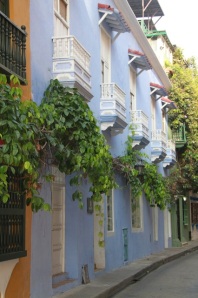 Colombia. Half of me wants to shout it from the rooftops and tell the whole world. The other half wants to keep it quiet lest popularity spoils its charm. It was once Spain’s main port and gateway to the Americas for bringing in slaves and was the central bank of the Spanish colonial world repatriating looted gold back to the homeland. After being continually besieged by pirates and would-be invaders, the Spanish protected its most important city by building Las Murallas, a circle of thick stonewall. Today that wall, most of which still stands, provides visitors with an ideal platform for walking around the city never far from the ocean glistening in the sunshine.
Colombia. Half of me wants to shout it from the rooftops and tell the whole world. The other half wants to keep it quiet lest popularity spoils its charm. It was once Spain’s main port and gateway to the Americas for bringing in slaves and was the central bank of the Spanish colonial world repatriating looted gold back to the homeland. After being continually besieged by pirates and would-be invaders, the Spanish protected its most important city by building Las Murallas, a circle of thick stonewall. Today that wall, most of which still stands, provides visitors with an ideal platform for walking around the city never far from the ocean glistening in the sunshine.
Cartagena’s sleepy laid-back atmosphere, narrow streets  and elegant, authentic
and elegant, authentic
architecture make it a joy to simply mooch around. Set off walking without intent or purpose and you will find treasures at every turn. The city’s houses are painted a kaleidoscope of colours, the charming balconies often festooned with flowers and, at night, lanterns. Peek inside the huge wooden porticos and you will see fountains and statues; duck down an alleyway and there will be a tiny cafe, bar or little shop.
 Occasionally the streets converge, opening out into a large plaza, like the leafy Plaza de Bolivar where the old men are sitting on benches, talking and laughing together. Or the San Pedro Plaza, where you can stop at the restaurant San Pedro and eat great food while enjoying front-row seats to the spectacle of every day life being played out among the metal life-sized statues outside.
Occasionally the streets converge, opening out into a large plaza, like the leafy Plaza de Bolivar where the old men are sitting on benches, talking and laughing together. Or the San Pedro Plaza, where you can stop at the restaurant San Pedro and eat great food while enjoying front-row seats to the spectacle of every day life being played out among the metal life-sized statues outside.
To get an eagle’s eye view of the old city and the modern one sprawling in the distance we went to the Castillo de San Felipe de Barajas, the defensive fort honeycombed by a complex system of tunnels that not only allowed easy movement but acted as an echo chamber to detect sneaky intruders. There are also equally impressive views from the Convento de la Popa, the highest point in the city, reached via a steep drunkenly zig-zagging road where every year, penitents achingly follow the stations of the cross.
we went to the Castillo de San Felipe de Barajas, the defensive fort honeycombed by a complex system of tunnels that not only allowed easy movement but acted as an echo chamber to detect sneaky intruders. There are also equally impressive views from the Convento de la Popa, the highest point in the city, reached via a steep drunkenly zig-zagging road where every year, penitents achingly follow the stations of the cross.
 There are several museums well worth a visit (and a great way of escaping the sometimes intense heat). Together they help piece together the rich and sometimes violent history of Colombia’s early development. Probably most atmospheric is the beautiful Convento and Inglesia de San Pedro Claver, named after the Jesuit monk who devoted his life to caring for the slaves brought from Africa, buying and freeing many of them. The nearby Palacio de la Inquisicion, is where the church’s inquiries into heresy and witchcraft were carried out with examples of the brutal instruments of torture. Despite its gruesome legacy it’s fascinating, with pictures and original models showing the city’s gradual evolution over the years.
There are several museums well worth a visit (and a great way of escaping the sometimes intense heat). Together they help piece together the rich and sometimes violent history of Colombia’s early development. Probably most atmospheric is the beautiful Convento and Inglesia de San Pedro Claver, named after the Jesuit monk who devoted his life to caring for the slaves brought from Africa, buying and freeing many of them. The nearby Palacio de la Inquisicion, is where the church’s inquiries into heresy and witchcraft were carried out with examples of the brutal instruments of torture. Despite its gruesome legacy it’s fascinating, with pictures and original models showing the city’s gradual evolution over the years.
As dusk approaches, visitors and locals alike congregate at the bar on top of la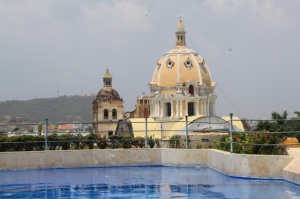 murallas and we nab a table right on the edge looking out over the ocean. This is the place to people-watch while nature lays on a spectacular sunset before a leisurely ride back into the heart of the city by traditional horse-drawn carriage. And dinner. This is serious seafood territory. La Cevicheria, tiny and tucked away, is known for its version of fresh fish “cooked” in citrus that you will find versions of across South America. Or you could get an awesome meal with a view at the rooftop restaurant at the Charleston Hotel. But honestly, it’s hard to get a bad meal in Cartagena.
murallas and we nab a table right on the edge looking out over the ocean. This is the place to people-watch while nature lays on a spectacular sunset before a leisurely ride back into the heart of the city by traditional horse-drawn carriage. And dinner. This is serious seafood territory. La Cevicheria, tiny and tucked away, is known for its version of fresh fish “cooked” in citrus that you will find versions of across South America. Or you could get an awesome meal with a view at the rooftop restaurant at the Charleston Hotel. But honestly, it’s hard to get a bad meal in Cartagena.
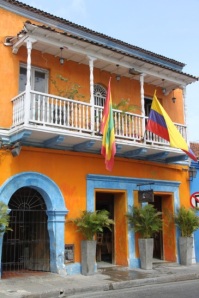 Just an easy walk from the walled city, past the wharf where the pirate ship is moored, is Getsemani, traditionally the poorer end of town; more cosmopolitan if more dilapidated. Here, the streets are even narrower and it’s impossible not to follow the aromas and music mingling in the air as you walk and sticky beak inside the open windows. Expect a cheerful greeting if you get caught! Keep an eye out for the murals like in the pretty Plaza de la Trinidad, rally
Just an easy walk from the walled city, past the wharf where the pirate ship is moored, is Getsemani, traditionally the poorer end of town; more cosmopolitan if more dilapidated. Here, the streets are even narrower and it’s impossible not to follow the aromas and music mingling in the air as you walk and sticky beak inside the open windows. Expect a cheerful greeting if you get caught! Keep an eye out for the murals like in the pretty Plaza de la Trinidad, rally 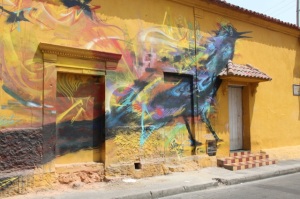 point for the revolution of 1811. Inevitably there is change here too. The buildings are being restored to their full beauty. Traditional backpackers’ accommodation is morphing into boutique hotels; smart bars and Western style cafes are appearing. At night, despite the growing number of salsa bars and clubs popping up, the place to be in
point for the revolution of 1811. Inevitably there is change here too. The buildings are being restored to their full beauty. Traditional backpackers’ accommodation is morphing into boutique hotels; smart bars and Western style cafes are appearing. At night, despite the growing number of salsa bars and clubs popping up, the place to be in
 Cartagena is still Cafe Havana. Salsa rocks South America and there seem to be as many varieties as there are bands. In Cartagena, the Champeta style, which draws heavily on the African roots of the population, is strong. This is the home of Ane Swing, the dreadlocked king of Champeta, who often plays at large concerts laid on for the visiting cruise liners. But if you are lucky, you can catch him jamming at one of the small local clubs. Unforgettable.
Cartagena is still Cafe Havana. Salsa rocks South America and there seem to be as many varieties as there are bands. In Cartagena, the Champeta style, which draws heavily on the African roots of the population, is strong. This is the home of Ane Swing, the dreadlocked king of Champeta, who often plays at large concerts laid on for the visiting cruise liners. But if you are lucky, you can catch him jamming at one of the small local clubs. Unforgettable.
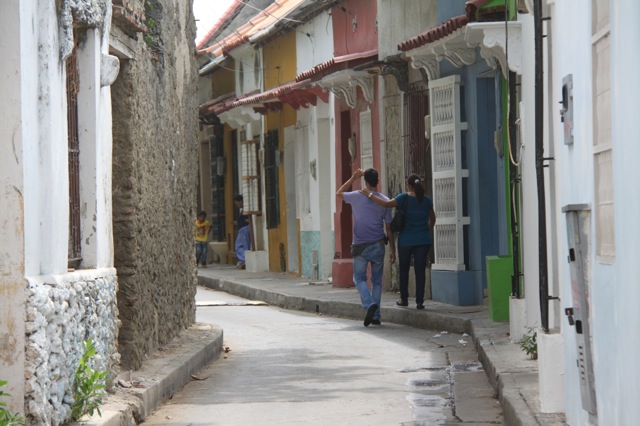





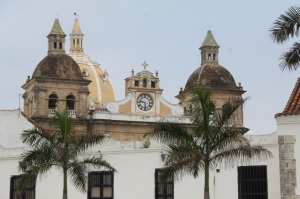


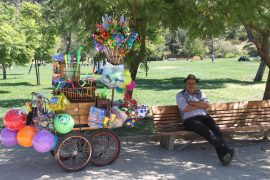

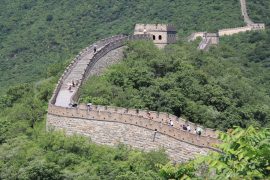
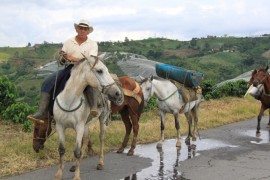
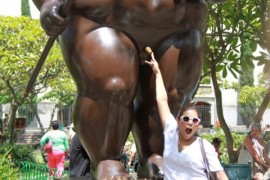
Comments are closed.